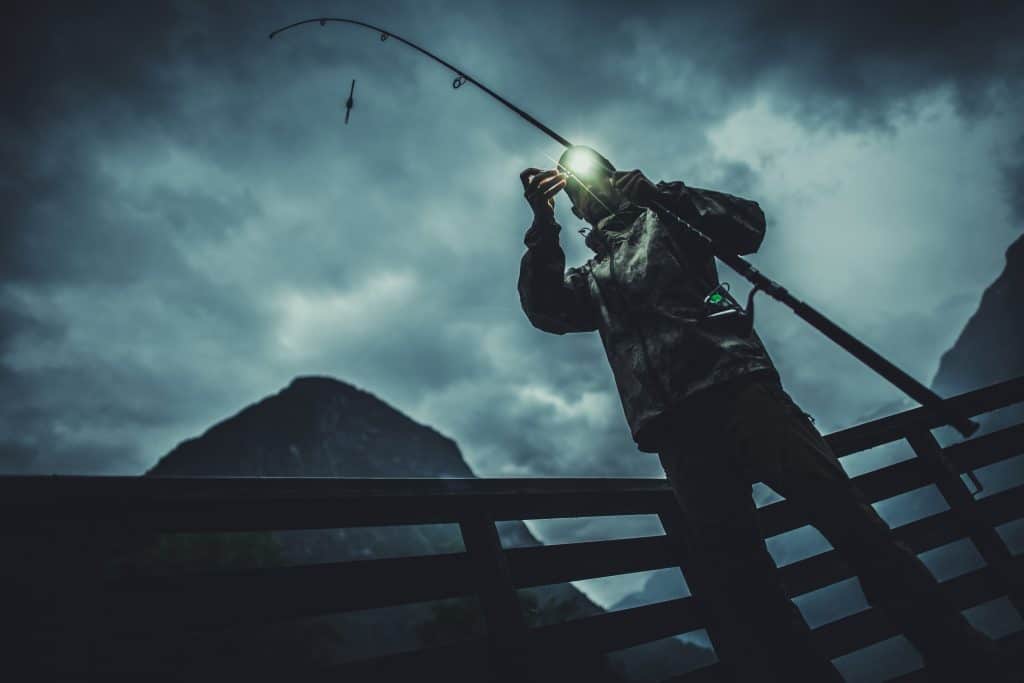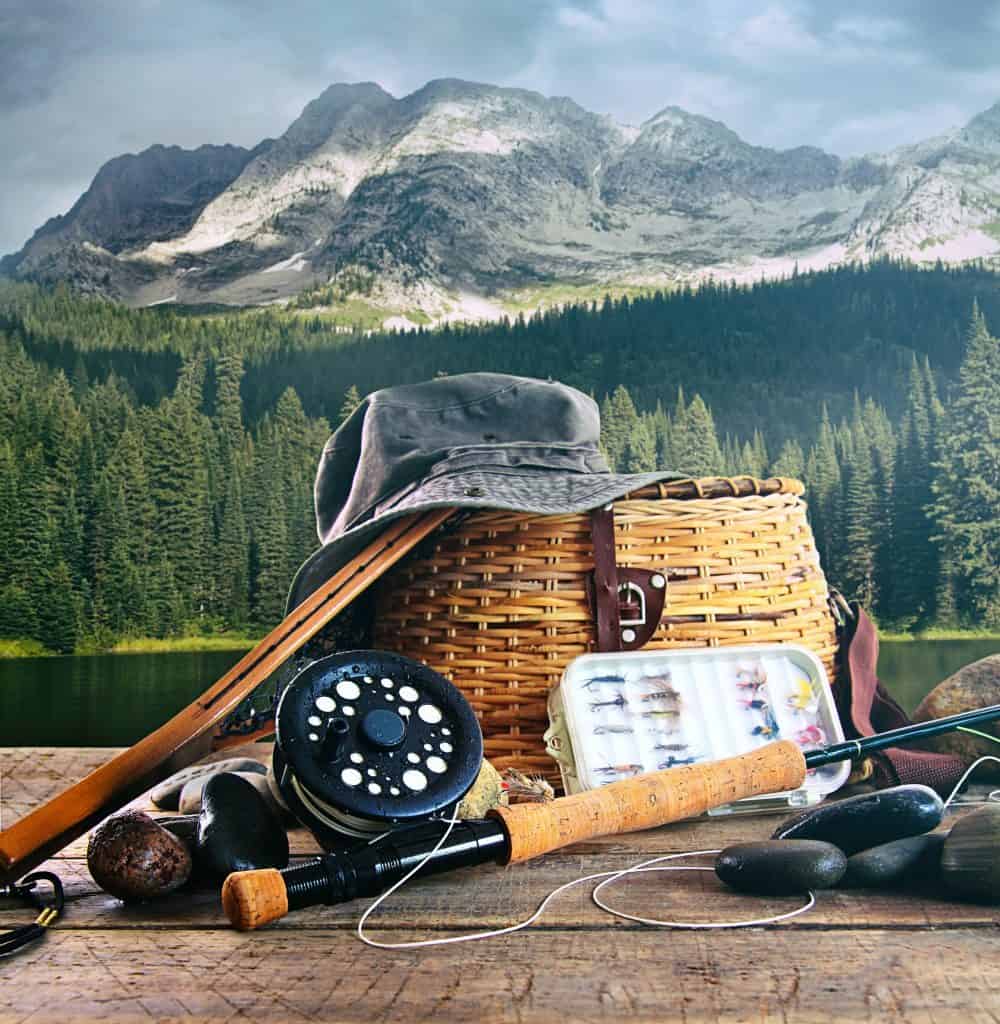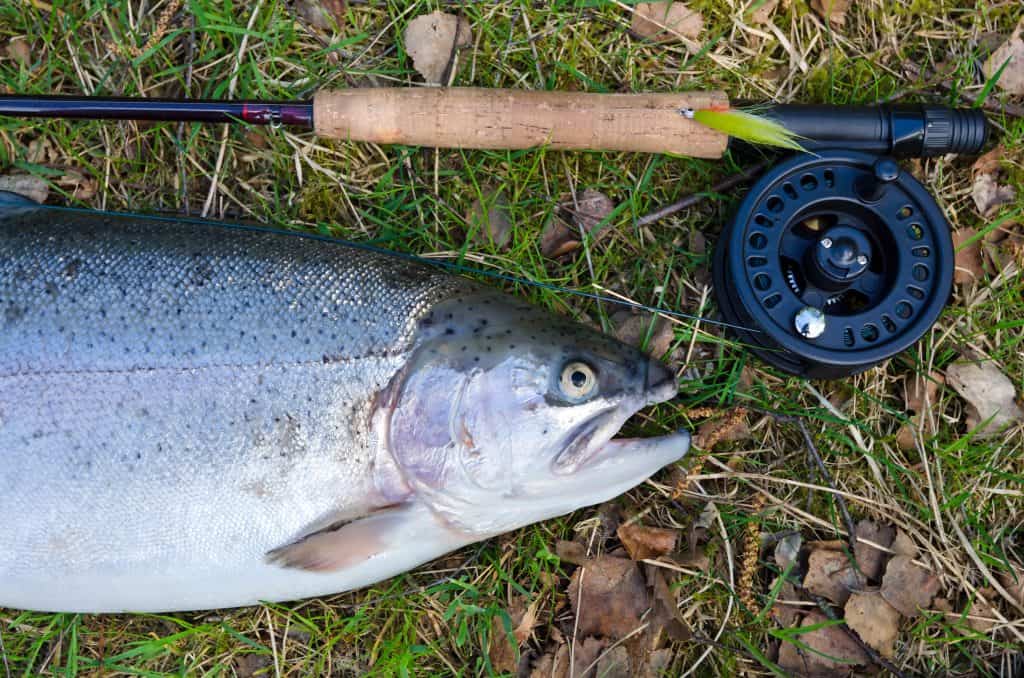
Kokanee salmon are actually Sockeye salmon that do not migrate back to the ocean. Most of the time, Kokanee are landlocked in lakes or small offshoots of rivers. Some live in rivers that head back to the ocean, but they do not have the instinct to go to the ocean.
So, how do you catch Kokanee salmon during the winter? Use an ice auger to cut through the ice and create a hole. Drop a line down the hole to the level where the salmon will be. Kokanee will bite pinks, but they will also bite cured corn if it was left out in garlic overnight. One kernel of the corn will be enough to attract them to the hook.
Kokanee salmon tend to bite more when they are annoyed than when they are looking for food. Since they are so aggressive, it is our job, as fishermen, to tap into that natural instinct, using it to our advantage to catch more fish.
Ice Fishing for Kokanee
Ice fishing is a type of fishing that is usually only done in the winter. There are a few different reasons for that. The water has to be frozen over pretty thick.
While it can be cold enough in Fall and early Spring, the minimum ice thickness a human should ever go on without fearing falling in is about 3 inches, and 5 if there are more than two people. This can happen in late fall and sometimes carry out until early spring, but there is the danger that it will not be thick enough.
There are also regulations on how many holes you can have, as well as how big you can make a hole. The max number of holes that a fisherman can have at once is usually 3-5. In Idaho, the max is 3 per person. The max diameter a hole can be is 10 inches.
If it is bigger you can get a pretty big fine on your head. But to be completely honest, there really is not a reason to go bigger than 8 inches. You are just trying to get a line down and pull out a fish that is probably around 4 inches in diameter
The fish will also not follow a lot of their regular schedules. While they are more likely to bite in the morning and evening feeding times, there is no guarantee that you will catch one or even attract a fish around this time.
There is about the same guarantee that you will catch Kokanee around noon as there is at 6 AM, which are when salmon’s feeding times are.
Equipment for Kokanee Fishing

The equipment that is needed for ice fishing can add a bit to the amount of money you have already put into fishing. Actually, I guarantee it. There is some equipment that is unique to ice fishing that you probably won’t use many other places.
Some of your equipment from other kinds of fishing will be able to transfer over, but for a good experience, new things will have to be bought.
Ice Auger
The first piece of new equipment is an ice auger. This is the tool that you use to cut holes in the ice to fish from. Ice augers come in either a hand powered auger, or an engine powered one.
The hand powered ones are cheaper by a lot. They usually run for around $80 for a 10-inch diameter auger to $40 for an 8-inch diameter one. On the tip of the auger, there is a blade that is angled to be able to scrape the ice away. The body of the auger is shaped like a screw, so it carries out most of the slush and ice shavings as they are separated.
The engine powered augers run for about $250 for one that is 8 inches in diameter to anywhere over $400 for one that is 10 inches. These are able to start in very cold temperatures. Some come with special ‘ripper’ blades that will be able to ear through the ice with ease.
Augers are a necessity only if going to places that people usually do not go. If your intent to go somewhere where you know people like to ice fish, then instead look for holes already drilled out and fish those.
Ice Rod
Ice rods are different than most types of rods. When websites talk about rods being 2′ to 14′, there is really only one type of rod that is two feet: Ice
Most are very slow actions compared to other rods. These bend nearly right at the blank but are very sensitive when it comes to being a strike indicator. Most of the time, though, the ice rods are laid on the ground or in a rod holder. The air is cold, so it is taxing holding the rod.
A good ice rod for beginners is the Ultralite Fishing Combo sold by Master Fishing Tackle. This is a rod that is cheap, but is of good quality and will work well with someone not used to ice fishing.
A great professional rod that I found to be a great rod is the Thorne Bro’s Wicked 13 Rod Combo. It is a bit pricey for the size of the rod, but it works wonders on the lakes.
You can use a regular rod for this, but the larger rods are hard to maneuver around. You will end up standing 6 or 7 feet away from the hole. It will be hard to get the fish out of the water, but it can be done.
Homemade ‘rods’ are also common. There really is not much of a need for an actual rod. I have used sticks and cheap bobbers before. I tied a line to a stick and let out around 30 feet of line and attached a bobber about a foot of line away from the stick, then I would just reel in the line with my hand.
It is not the most pretty method, but it gets the job done.
Line
The smallest line that you can get away with is what you should work with. When I am targeting Kokanee Salmon, I usually run 10 lbs of
The average size of a Kokanee is just above 9 lbs, so you could get away pretty easily with 8 lb line.
I have had pretty good success with monofilament line, because of how invisible it is, especially when in the dark water. I would like to try using braided line because it is very sensitive. I also want to try fluorocarbon line, but 30 feet of fluorocarbon would be super expensive for one line.
The kokanee fish are very finicky, and they notice the line quite frequently. Mono is used frequently more than the other types of lines.
Tent

This is not a needed accessory, but it does help a lot to be able to keep your heat in one area. The tent is just a small little pop up that you are able to stand up in.
There is a door on one side as well as the bottom open to fish the ice. There is enough room, usually, for about 3 holes, which is the limit most places have on fishermen.
Usually, these tents can get somewhat expensive (in the range of $400) but I found one on Amazon for $90 that is big enough for two people, has vents for ventilation, is waterproof, and packs down pretty small. Its a good price for staying warm, and believe me. It is hard staying warm out there on a completely frozen lake.
Techniques to Catch Kokanee
Ice fishing is very different than regular lake fishing, most reasons because of the physical differences between the two types. Ice fishing is considered a vertical fishing method, while other types are more horizontal. Lures and baits are used in both, but there are differences in how they are used.
Kokanee Lures
Lures are usually very action orientated and meant to be cast out and reeled in again and again. In ice fishing, they are still very action based, but the action is different. The lures are designed to zigzag back and forth as they are reeled straight up to the hole again.
The movement looks like a small fish trying to bite some food. If these lures come close to the Kokanee salmon, you know that they are going to get bit. The zigzag is especially sought after because the movement annoys many types of fish.
Some lures work best when they are bounced up and down. There are a large number of lures that are weighted to fall quickly. When the rod is bounced up and down, the keep the tension on the line the whole time, still move. These attract fish as well. This type of action is called jigging, which differs from the hooks called jigs
Most of those kinds of lures are plastics or jigs. This type of action works very well for jigs and other fake baits.
Kokanee’s Favorite Baits
Real bait has a very secure place in ice fishing. One thing that lures cannot imitate by themselves is a
There are some baits that smell better than others to the fish. Live baits are very good for some of those more aggressive fish. The best live baits to use in ice fishing are minnows, leeches, worms, and maggots. Kokanee Salmon love to attack pink-dyed maggots, but I have also had some success with worms on the end of a single hook.
For fishing with minnows, make sure that the minnows are alive when you hook them and also stay alive when put into the water. There is sometimes the concern that they die when exposed to the cold water. They will swim around and attract aggressive fish. They usually have to be switched out every cast or so.
Most maggots have a natural stink that is very attractive to the fish. Most anglers attach a maggot to a lure because it is small enough to not mess up the action of the lure, but also has a very strong scent that will bring more fish to the lure.
Location of the Kokanee Salmon

The locations that the Kokanee are does not seem to be an exact point. Kokanee will travel very far distances to eat. The best way to find a fish is with a fish sonar, and ice fishing is no exception.
Fishing sonars are expensive. Most are around $140, but there really is not a cap on how expensive they go after that. The best ones around $300, but the cheaper ones will work fine. What they tell you is whether there is Kokanee Salmon under your hole or not. If there is, you should fish there. If not, go dig another hole.
Most Kokanee salmon are not that active past 9 or 10 am, but there will still be fish swimming around that will sometimes bite. Kokanee salmon swim anywhere from 25 feet down. This is where the baitfish swim, or at least underneath where they swim.
Start fishing around 10 feet down with your lure or bait. If you have success, then fish there. If not, though, then fish lower until you get a fish. Make sure not to fish too close to the bottom of the lake. Kokanee salmon are not bottom-feeders, but they will hang out around 1 or 2 feet off the ground.
By placing a baitfish on a hook and getting it down deep, you will have the highest chance of getting a fish on the hook.
When deciding the location of your holes, try making a hole every 30 feet at a right angle in relation with the shore. Kokanee salmon is known to travel pretty much completely parallel with the bank of the shore, so having multiple lines out each at different distances from the shore will maximize your chances of having a fish see and bite your hook.
Kokanee require a certain amount of oxygen, so they won’t be found in some of the smaller lakes in regions stocked with Kokanee salmon. It is a lot more likely for the larger lakes to be stocked with Kokanee salmon because they will have the correct oxygen levels that will be able to support the fish. The Kokanee will also be at shallower places if there is less oxygen in the water.
Related Questions:
Do Dodgers work well when fishing for Kokanee Salmon? Dodgers will attract the Kokanee Salmon closer to your holes and hooks. There is always a better chance if there is also a Dodger in the water with your hook than without using a Dodger. Different fishers will have different results, but Kokanee do respond well to dodgers.
Will ice fishing with a spinning lure catch Kokanee Salmon? The action of the spinning lure is meant for casting and retrieving. They do not work well with vertical jigging which is the best technique to catch a Kokanee Salmon. Try a spoon or a jig. They are usually cheaper and have better results.
